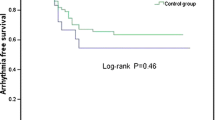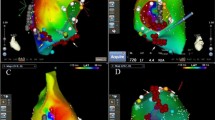Abstract
Background
Prior investigators note successful ablation of both typical cavotricuspid isthmus-dependent and scar-related macroreentrant right atrial flutters (AFL) in adult patients with repaired tetralogy of Fallot (TOF). However, an analysis of the mechanisms (including a description of a uniform approach to diagnose such mechanisms), and clinical outcomes of catheter ablation in a consecutive series of adult patients with AFL late after surgical TOF repair has not been previously reported.
Methods
Background clinical data and follow-up were evaluated in a consecutive series of TOF patients evaluated from September 2001 to June 2008.
Results
We report a prevalence of sustained, symptomatic AFL in patients with repaired TOF equal to 20% (28/140 patients), and of recurrent, drug-refractory and/or severely symptomatic AFL to be 11% (16/140 patients). The AFLs manifested variable cycle lengths ranging from 215 to 525 ms. Underlying mechanisms were: (1) cavotricuspid (CTI)-dependent, counterclockwise atrial flutter (n = 8 patients); (2) non-CTI-dependent macroreentrant scar-related AFL (n = 6 patients); and (3) both CTI- and non-CTI-dependent macroreentrant AFL (n = 2 patients). Recurrent arrhythmias occurred in six patients, five of whom were successfully treated with repeat ablation. After a mean follow-up of 23 months, 15 of 16 patients were alive and free of sustained AFL.
Conclusions
AFL late after surgical TOF repair occurs in 20% of such patients. In more than half of these patients, the AFLs are drug-refractory and/or severely symptomatic. Despite the presence of congenital heart disease treated with prior cardiac surgery and AFLs with variable atrial cycle lengths, the CTI-dependent mechanism underlies approximately half of the sustained, symptomatic AFLs.




Similar content being viewed by others
Abbreviations
- AFL:
-
Atrial flutter
- RA:
-
Right atrium
- EP:
-
Electrophysiological
- CTI:
-
Cavotricuspid isthmus
- TOF:
-
Tetralogy of Fallot
- RFA:
-
Radiofrequency ablation
References
Walsh, E. P. (2007). Interventional electrophysiology in patients with congenital heart disease. Circulation, 115(25), 3224–3234.
Garson, A., Jr., Bink-Boelkens, M., Hesslein, P. S., Hordof, A. J., Keane, J. F., Neches, W. H., et al. (1985). Atrial flutter in the young: a collaborative study of 380 cases. Journal of the American College of Cardiology, 6(4), 871–878.
Karamlou, T., Silber, I., Lao, R., McCrindle, B. W., Harris, L., Downar, E., et al. (2006). Outcomes after late reoperation in patients with repaired tetralogy of Fallot: the impact of arrhythmia and arrhythmia surgery. Annals of Thoracic Surgery, 81(5), 1786–1793; discussion 1793.
Harrison, D. A., Siu, S. C., Hussain, F., MacLoghlin, C. J., Webb, G. D., & Harris, L. (2001). Sustained atrial arrhythmias in adults late after repair of tetralogy of fallot. American Journal of Cardiology, 87(5), 584–588.
Nakagawa, H., Shah, N., Matsudaira, K., Overholt, E., Chandrasekaran, K., Beckman, K. J., et al. (2001). Characterization of reentrant circuit in macroreentrant right atrial tachycardia after surgical repair of congenital heart disease: isolated channels between scars allow “focal” ablation. Circulation, 103(5), 699–709.
Triedman, J. K., Alexander, M. E., Berul, C. I., Bevilacqua, L. M., & Walsh, E. P. (2001). Electroanatomic mapping of entrained and exit zones in patients with repaired congenital heart disease and intra-atrial reentrant tachycardia. Circulation, 103(16), 2060–2065.
Van Hare, G. F., Lesh, M. D., & Stanger, P. (1993). Radiofrequency catheter ablation of supraventricular arrhythmias in patients with congenital heart disease: results and technical considerations. Journal of the American College of Cardiology, 22(3), 883–890.
Collins, K. K., Love, B. A., Walsh, E. P., Saul, J. P., Epstein, M. R., & Triedman, J. K. (2000). Location of acutely successful radiofrequency catheter ablation of intraatrial reentrant tachycardia in patients with congenital heart disease. American Journal of Cardiology, 86(9), 969–974.
Triedman, J. K., Saul, J. P., Weindling, S. N., & Walsh, E. P. (1995). Radiofrequency ablation of intra-atrial reentrant tachycardia after surgical palliation of congenital heart disease. Circulation, 91(3), 707–714.
Van Hare, G. F., Lesh, M. D., Ross, B. A., Perry, J. C., & Dorostkar, P. C. (1996). Mapping and radiofrequency ablation of intraatrial reentrant tachycardia after the senning or Mustard procedure for transposition ofthe great arteries. American Journal of Cardiology, 77(11), 985–991.
Peichl, P., Kautzner, J., Cihak, R., Vancura, V., & Bytesnik, J. (2003). Clinical application of electroanatomical mapping in the characterization of “incisional” atrial tachycardias. Pacing and Clinical Electrophysiology, 26(1 Pt 2), 420–425.
Chan, D. P., Van Hare, G. F., Mackall, J. A., Carlson, M. D., & Waldo, A. L. (2000). Importance of atrial flutter isthmus in postoperative intra-atrial reentrant tachycardia. Circulation, 102(11), 1283–1289.
Kanter, R. J., Papagiannis, J., Carboni, M. P., Ungerleider, R. M., Sanders, W. E., & Wharton, J. M. (2000). Radiofrequency catheter ablation of supraventricular tachycardia substrates after mustard and senning operations for d-transposition of the great arteries. Journal of the American College of Cardiology, 35(2), 428–441.
Tanner, H., Lukac, P., Schwick, N., Fuhrer, J., Pedersen, A. K., Hansen, P. S., et al. (2004). Irrigated-tip catheter ablation of intraatrial reentrant tachycardia in patients late after surgery of congenital heart disease. Heart Rhythm, 1(3), 268–275.
Halimi, F., Marquez, M., Lacotte, J., Hidden-Lucet, F., Tonet, J., & Frank, R. (2008). Three-dimensional electroanatomical mapping of right periatriotomy tachycardias after interatrial defect correction. Archives of Cardiovascular Diseases, 101(9), 533–538.
Triedman, J. K., Bergau, D. M., Saul, J. P., Epstein, M. R., & Walsh, E. P. (1997). Efficacy of radiofrequency ablation for control of intraatrial reentrant tachycardia in patients with congenital heart disease. Journal of the American College of Cardiology, 30(4), 1032–1038.
Roos-Hesselink, J., Perlroth, M. G., McGhie, J., & Spitaels, S. (1995). Atrial arrhythmias in adults after repair of tetralogy of Fallot. Correlations with clinical, exercise, and echocardiographic findings. Circulation, 91(8), 2214–2219.
Walsh, E. P. (2002). Arrhythmias in patients with congenital heart disease. Cardiac Electrophysiology Review, 6(4), 422–430.
Triedman, J. K., Alexander, M. E., Love, B. A., Collins, K. K., Berul, C. I., Bevilacqua, L. M., et al. (2002). Influence of patient factors and ablative technologies on outcomes of radiofrequency ablation of intra-atrial re-entrant tachycardia in patients with congenital heart disease. Journal of the American College of Cardiology, 39(11), 1827–1835.
Kannankeril, P. J., Anderson, M. E., Rottman, J. N., Wathen, M. S., & Fish, F. A. (2003). Frequency of late recurrence of intra-atrial reentry tachycardia after radiofrequency catheter ablation in patients with congenital heart disease. American Journal of Cardiology, 92(7), 879–881.
Feld, G. K., Fleck, R. P., Chen, P. S., Boyce, K., Bahnson, T. D., Stein, J. B., et al. (1992). Radiofrequency catheter ablation for the treatment of human type 1 atrial flutter. Identification of a critical zone in the reentrant circuit by endocardial mapping techniques. Circulation, 86(4), 1233–1240.
Kalman, J. M., Olgin, J. E., Saxon, L. A., Fisher, W. G., Lee, R. J., & Lesh, M. D. (1996). Activation and entrainment mapping defines the tricuspid annulus as the anterior barrier in typical atrial flutter. Circulation, 94(3), 398–406.
Kirkorian, G., Moncada, E., Chevalier, P., Canu, G., Claudel, J. P., Bellon, C., et al. (1994). Radiofrequency ablation of atrial flutter. Efficacy of an anatomically guided approach. Circulation, 90(6), 2804–2814.
Nakagawa, H., Lazzara, R., Khastgir, T., Beckman, K. J., McClelland, J. H., Imai, S., et al. (1996). Role of the tricuspid annulus and the eustachian valve/ridge on atrial flutter. Relevance to catheter ablation of the septal isthmus and a new technique for rapid identification of ablation success. Circulation, 94(3), 407–424.
Olgin, J. E., Kalman, J. M., Fitzpatrick, A. P., & Lesh, M. D. (1995). Role of right atrial endocardial structures as barriers to conduction during human type I atrial flutter. Activation and entrainment mapping guided by intracardiac echocardiography. Circulation, 92(7), 1839–1848.
Scavee, C., Jais, P., Hsu, L. F., Sanders, P., Hocini, M., Weerasooriya, R., et al. (2004). Prospective randomised comparison of irrigated-tip and large-tip catheter ablation of cavotricuspid isthmus-dependent atrial flutter. European Heart Journal, 25(11), 963–969.
Acknowledgments
The authors would like to thank Ms. Cecille Garcia, N.P., for her assistance with data collection and Ms. AnnaMaria Arias for assistance with manuscript preparation.
Funding Sources
Funded in part by a grant from the New York State Empire Clinical Research Investigator Program (Dr. Biviano).
Disclosures
The authors report no conflicts related to this article.
Author information
Authors and Affiliations
Corresponding author
Additional information
Biviano, atrial flutter in tetralogy of Fallot, and catheter ablation outcomes
Rights and permissions
About this article
Cite this article
Biviano, A., Garan, H., Hickey, K. et al. Atrial flutter catheter ablation in adult patients with repaired tetralogy of Fallot: mechanisms and outcomes of percutaneous catheter ablation in a consecutive series. J Interv Card Electrophysiol 28, 125–135 (2010). https://doi.org/10.1007/s10840-010-9477-5
Received:
Accepted:
Published:
Issue Date:
DOI: https://doi.org/10.1007/s10840-010-9477-5




